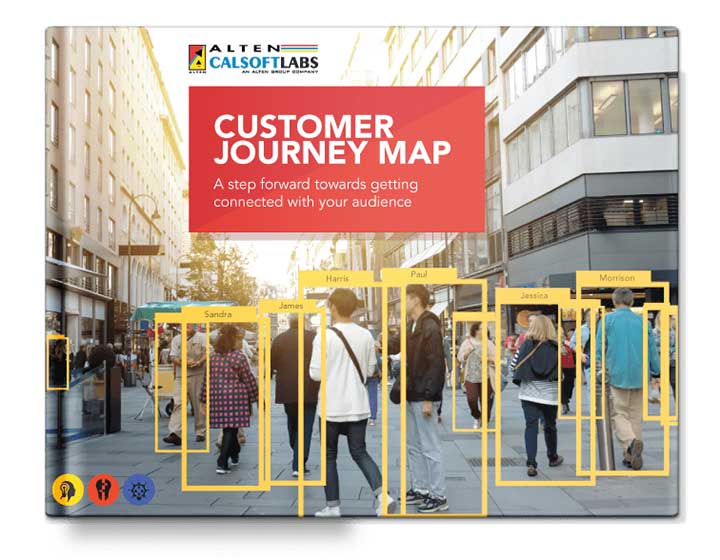

ACL Digital
Customer Journey Mapping Tools for a Compelling Customer Experience
Today, marketers and customer experience designers work in an exceedingly challenging environment, where technology is getting better day by day and newer marketing channels are coming into existence every now and then. Customers expect to shop, compare and purchase on their own terms from different channels across various devices. It is utmost important for an organization to produce a clear and consistent voice across all the communication channels and to listen to their customers’ story as well. It’s time for marketers to rethink whether they really understand their customers well: what they like; what they don’t like; what makes them upset; what they expect; where they want to interact, etc. This kind of detailing can only be obtained from stories, and one such storytelling tool used in business is Customer Journey Map, and to come up with one, organizations are turning towards the process of customer journey mapping through use of readily available customer journey mapping tools or frameworks.
A customer journey map makes the invisible visible, it’s basically a visual representation of an end-to-end customer experience. An organization can use customer journey map to focus on a part of the narrative or be an overview of the entire customer experience. It gives insights on what customers want to achieve and what they expect from the organization, helping teams across an organization understand how the customers think, feel, see or do. So, ultimately gaps in the pre-defined customer experience can be identified and new strategies can be built to enhance the experience by keeping the customer at the center of organization’s thinking.
Now, here I would like to list down the numerous reasons of using customer journey map leveraging journey mapping tools to enhance or revamp the overall customer experience:
1. Customer-centric experiences:
A customer journey map could assist in changing the focus of an organization from internal systems on to the thoughts, actions and emotions of customers and could bring into light the real human experiences that organizations often do not see. This way an organization would be able to understand the customer’s perspective, needs, desires by referring their past behaviors, delivering customer-centric experiences.
2. Consistency across channels:
An organization usually have multiple channels to interact with the customers, which definitely helps them create more customer touchpoints but also sometimes causes inconsistency across the channels. For example, suppose Mike has purchased a movie ticket using his laptop over the website and while he reached the theatre, he tried using the mobile app to access the ticket but was unable to access it. A customer journey map could highlight: gaps between devices when the user switches from one device to another; gap between departments where the user might lose patience; or gaps between channels when user goes to the website from a social media platform.

3. Break down organization-wide silos:
A customer journey map could help break down silos establishing cross-department conversation and collaboration because it highlights every interaction of a customer with the organization across the entire customer journey. It also points out the areas of friction, thereby it could be considered as the first step in an organization-wide plan to invest on omnichannel customer experience.
4. Exceed customer expectations:
Meeting customer’s expectation is not enough in today’s highly competitive world, it’s necessary to differentiate customer experience from others to stay unique in the crowd. A customer Journey map could make it easier for organizations to identify voids between the intended and perceived customer experience.
5. Personalized customer experience:
Customer journey maps help organizations to intelligently identify the right set of customers to target by understanding the differences and similarities across the journeys of multiple personas or customers. It even helps to prioritize on a high-value persona and explore ways to attract a new type of customer. Eventually, a customer journey map can help an organization to provide their customers a personalized experience. With high degree of personalization, an organization recognizes its customer by their name, sends personalized offers and notifications based on their past purchases, needs and behaviour. So, eventually creates an atmosphere that makes customer feel special.
6. Values-driven decision making:
Through quantitative research, customer experience metrics can be captured for specific journey stages or touchpoints. If it is found through analytics that something in the organization is not going well, like sales-drop or underutilized online tool; journey mapping will help in finding out the reason. It basically empowers stakeholders to make values-driven decisions for overcoming the roadblocks, fabricating an improved customer experience.
7. Discover tools & technologies:
Today, customers are highly demanding and impatient, they don’t even take a minute to switch the service provider or the product when there is an issue or a glitch. So, it is very crucial for an organization to keep a constant tap on their customers, listening to their feedbacks across channels and address the issues promptly. It’s hard manually responding to every feedback or query, there is a definite need of identifying advanced tools and technologies. Customer journey mapping helps you discover technologies streamlined for industry or audience specific marketing and communication strategies. This results in customer loyalty, increased revenue and brand advocacy. For example, one can invest in a multi-channel marketing automation tool.
To decrease marketing fatigue, construct a satisfying and coherent customer experience for your brand. For greater conversion rates: plan, execute and analyze campaigns more effectively over various channels. Delivering the experience that the customers deserve can help you achieve a unique position in the marketplace. Without any doubt, investing in customer journey mapping tools or coming up with a home-grown framework leveraging customer journey mapping techniques can improve the customer experience by 2x.




